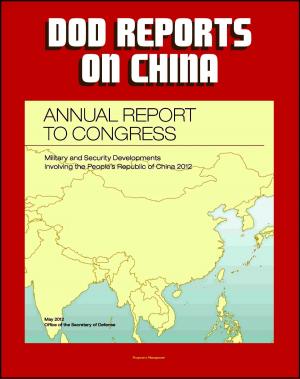The Effective Use of Labels in Strategic Communication: Case Studies of Jewish Threat Propaganda in Nazi Germany, Countering Boko Haram and ISIS, and Use of Labels in U.S. Government Communication
Nonfiction, Social & Cultural Studies, Political Science, International| Author: | Progressive Management | ISBN: | 9780463209516 |
| Publisher: | Progressive Management | Publication: | May 13, 2018 |
| Imprint: | Smashwords Edition | Language: | English |
| Author: | Progressive Management |
| ISBN: | 9780463209516 |
| Publisher: | Progressive Management |
| Publication: | May 13, 2018 |
| Imprint: | Smashwords Edition |
| Language: | English |
This excellent report has been professionally converted for accurate flowing-text e-book format reproduction.
Labels and brands are designed to evoke emotion in all of us. With time, these labels enter common vocabulary in unique and specific ways. Organizational labels establish the tone for the specific group-friendly groups as well as threat groups. The primary question is, "Should the application of labels toward threat groups factor into the communication of national strategy?" Because President Barak Obama emphasized the employment of strategic communication in the 2010 National Security Strategy, the United States must consider the labels used to address emerging threats. The informational instrument of national power must lead the national reaction to global security issues. The United States must be in the forefront of the conversation as the global discussion continues of how to refer to adversarial or threat groups such as ISIS. The purpose of this thesis is to demonstrate the importance the labeling of threat groups is to information as a source of national power. The efficient use of information will serve to set the tone for unified action against threat groups and adversaries. National leadership must clearly express the national strategic direction for all governmental, military, non-governmental, private sector organizations, and others to follow.
CHAPTER 1 INTRODUCTION * Introduction * Background * Problem Statement * Primary Research Question * Secondary Research Questions * Methodology * Definition of Terms * Limitations * Delimitations * Chapter Summary * CHAPTER 2 LITERATURE REVIEW * Introduction * Proliferation of the "Jewish Threat" Propaganda in Nazi Germany (1933-1945) * Countering Boko Haram through Strategic Communication * Countering the Islamic State in Iraq and Syria through Strategic Communication * The Use of Labels in United States Government Strategic Communication * Additional Sources * Chapter Summary * CHAPTER 3 RESEARCH METHODOLOGY * Introduction * Methodological Approach * Thesis Questions * Case Study Methodology * Case Study Description * Evaluation Criteria * Chapter Summary * CHAPTER 4 DATA PRESENTATION AND ANALYSIS * Introduction * Proliferation of the "Jewish Threat" Propaganda in Nazi Germany in 1933-1945 * Introduction * History * Labels * Analysis * Summary and Application * Countering Boko Haram through Strategic Communication * Introduction * History * Labels * Analysis * Summary and Application * Countering the Islamic State in Iraq and Syria through Strategic Communication * Introduction * History * Labels * Analysis * Summary and Application * The Use of Labels in United States Government Strategic Communication 2001-2015 * Introduction * History * Labels * Analysis * Summary and Application * Chapter Summary and Conclusion * CHAPTER 5 CONCLUSIONS AND RECOMMENDATIONS * Introduction * Conclusions * Recommendations * Suggested Topics for Further Research. * Closing Thoughts * REFERENCE LIST
This excellent report has been professionally converted for accurate flowing-text e-book format reproduction.
Labels and brands are designed to evoke emotion in all of us. With time, these labels enter common vocabulary in unique and specific ways. Organizational labels establish the tone for the specific group-friendly groups as well as threat groups. The primary question is, "Should the application of labels toward threat groups factor into the communication of national strategy?" Because President Barak Obama emphasized the employment of strategic communication in the 2010 National Security Strategy, the United States must consider the labels used to address emerging threats. The informational instrument of national power must lead the national reaction to global security issues. The United States must be in the forefront of the conversation as the global discussion continues of how to refer to adversarial or threat groups such as ISIS. The purpose of this thesis is to demonstrate the importance the labeling of threat groups is to information as a source of national power. The efficient use of information will serve to set the tone for unified action against threat groups and adversaries. National leadership must clearly express the national strategic direction for all governmental, military, non-governmental, private sector organizations, and others to follow.
CHAPTER 1 INTRODUCTION * Introduction * Background * Problem Statement * Primary Research Question * Secondary Research Questions * Methodology * Definition of Terms * Limitations * Delimitations * Chapter Summary * CHAPTER 2 LITERATURE REVIEW * Introduction * Proliferation of the "Jewish Threat" Propaganda in Nazi Germany (1933-1945) * Countering Boko Haram through Strategic Communication * Countering the Islamic State in Iraq and Syria through Strategic Communication * The Use of Labels in United States Government Strategic Communication * Additional Sources * Chapter Summary * CHAPTER 3 RESEARCH METHODOLOGY * Introduction * Methodological Approach * Thesis Questions * Case Study Methodology * Case Study Description * Evaluation Criteria * Chapter Summary * CHAPTER 4 DATA PRESENTATION AND ANALYSIS * Introduction * Proliferation of the "Jewish Threat" Propaganda in Nazi Germany in 1933-1945 * Introduction * History * Labels * Analysis * Summary and Application * Countering Boko Haram through Strategic Communication * Introduction * History * Labels * Analysis * Summary and Application * Countering the Islamic State in Iraq and Syria through Strategic Communication * Introduction * History * Labels * Analysis * Summary and Application * The Use of Labels in United States Government Strategic Communication 2001-2015 * Introduction * History * Labels * Analysis * Summary and Application * Chapter Summary and Conclusion * CHAPTER 5 CONCLUSIONS AND RECOMMENDATIONS * Introduction * Conclusions * Recommendations * Suggested Topics for Further Research. * Closing Thoughts * REFERENCE LIST















